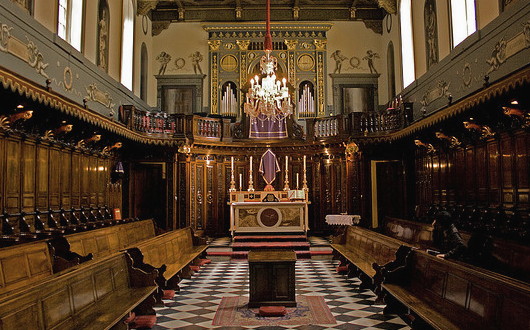Catholicism
About Andrew Cusack
 Writer, web designer, etc.; born in New York; educated in Argentina, Scotland, and South Africa; now based in London.
Writer, web designer, etc.; born in New York; educated in Argentina, Scotland, and South Africa; now based in London. read more
News
Blogs
Reviews & Periodicals
Arts & Design
World
France
Mitteleuropa
Knickerbockers
Argentina
The Levant
Africa
Cape of Good Hope
Netherlands
Scandinavia
Québec
India
Muscovy
Germany
Academica
Some Norwegian Catholics
Writers, politicians, journalists, academics — Norway’s Catholics seem an intellectual bunch. The Church in Scandinavia is on a slow but steady ascendant, and it’s telling (of both the rise and fall of many) that there are now more seminarians studying for the priesthood for the Nordic countries than there are for all of Ireland.
As a Norwegian acquaintance of ours was ordained for the Diocese of Oslo within the past year, I thought a little jaunt through a handful or two of Norwegian Catholics might be interesting. There are some I would have liked to included — the conversion of the former Lutheran ecumenist Ola Tjørhom provoked controversy and Wilhelm Wedel-Jarlsberg preceded Christopher de Paus as a papal chamberlain — but there is only so much time and space and effort.
Of those mentioned here below, only Sigrid Undset has achieved worldwide fame. Her work Kristin Lavransdatter is an absolute must for any serious reader of literature and was recently re-translated into English by Penguin. (more…)
The Lady Altar
The Oratory Church of the Immaculate Heart of Mary,
Brompton Road, London
In the south transept of the Brompton Oratory is the altar dedicated to the Blessed Virgin, perhaps the finest altar in the entire church. It is a favourite place for getting in a few prayers and offering a candle or two or three or four. At the end of Solemn Vespers & Benediction on Sunday afternoon (above) it is where the Prayer for England is said and the Marian antiphon sung.
The Lady Altar was designed and built in 1693 by Francesco Corbarelli of Florence and his sons Domenico and Antonio and for nearly two centuries stood in the Chapel of the Rosary in the Church of St Dominic in Brescia. That church was demolished in 1883, and the London Congregation of the Oratory purchased the altar two years beforehand for £1,550.
The statue of Our Lady of Victories holding the Holy Child had previously stood in the old Oratory church in King William Street, and the central space of the reredos was slightly modified to house it. The Old and New Worlds are represented in the flanking statues, which are of St Pius V and St Rose of Lima — both by the Venetian late-baroque sculptor Orazio Marinali. The statues of St Dominic and St Catherine of Siena which now rest in niches facing the altar were previously united to it, and are by the Tyrolean Thomas Ruer.
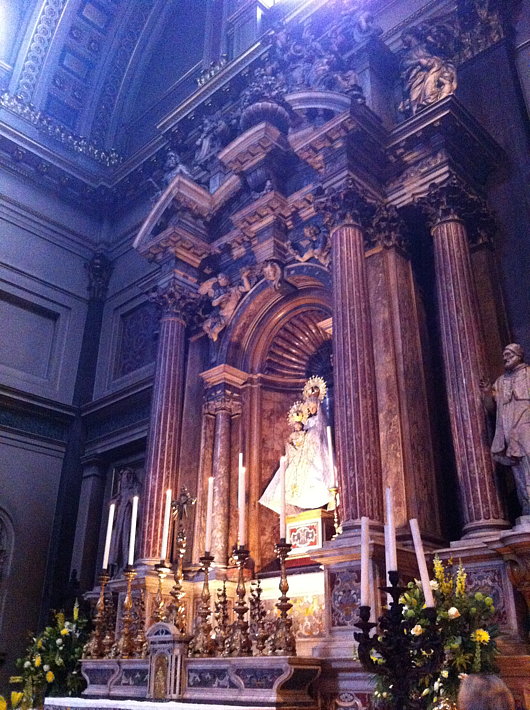
The Cathedral of the Bronx
The Augustinian Church of St Nicholas of Tolentine
The Church of St Nicholas of Tolentine dominates the busy intersection of University Avenue and West Fordham Road in the Bronx. The parish was erected by the archdiocese in 1906 and has been served by Augustinians ever since then. The present church is a modern gothic creation from 1927, and probably one of the most handsome Catholic churches in the borough — it is often nicknamed “the cathedral of the Bronx”. (Though that style is sometimes also ascribed to St Jerome’s in Mott Haven).
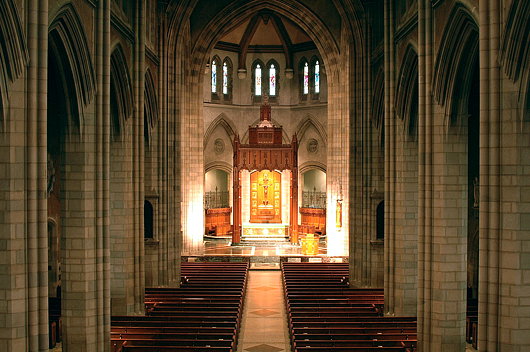
The church is of suitably grand proportions, but the effect is somewhat diminished by the unfortunate use of bulky wooden pews. They are ill-suited to such a large church, and detract from the spaciousness of the interior. This is unfortunately a very frequent problem in the United States, where clumsy pews crowd even great cathedral churches like St Patrick’s in Manhattan or the glorious Cathedral Basilica in St Louis. Regardless, St Nicholas of Tolentine is a splendid ornament in this borough of many churches. (more…)
Better late than never
Old hat already, but following the announcement of Benedict XVI’s abdication, the Los Angeles Times solicited opinions from eleven American Catholics — among them your humble & obedient scribe — what they would like to see in the new pope.
I posted in on Twitter, but in case you didn’t catch it there, you can find my contributions (in addition to those of the ten others) at this link. (more…)
Against the Dictatorship of Relativism
Pope Francis continues Benedict XVI’s fight
… But there is another form of poverty! It is the spiritual poverty of our time, which afflicts the so-called richer countries particularly seriously. It is what my much-loved predecessor, Benedict XVI, called the “dictatorship of relativism”, which makes everyone his own criterion and endangers the coexistence of peoples. And that brings me to a second reason for my name. Francis of Assisi tells us we should work to build peace. But there is no true peace without truth! There cannot be true peace if everyone is his own criterion, if everyone can always claim exclusively his own rights, without at the same time caring for the good of others, of everyone, on the basis of the nature that unites every human being on this earth.
“For those tempted to draw an overly sharp distinction between Pope Francis and his predecessor,” John Allen reports, “the new pope offered a clear reminder Friday that he may have a different style than Benedict XVI, but on substance, he’s cut from much the same cloth.”
“In a speech to the diplomatic corps accredited to the Holy See on Friday, Francis lamented not only the material poverty of the early 21st century but also its ‘spiritual poverty,’ meaning a rejection of God and objective standards of morality.”
Also, I found it interesting that the Holy Father noted that his background in an Argentine family of Italian origin impelled him in his role as bridge-builder. Naturally, as someone from an Estadounidense family of Irish origin, I feel a certain parallel kinship to this first American pope.
[Note: The boldface below is mine.] (more…)
From the provost
The Provost of the Brompton Oratory, Fr Julian Large, warns Catholics not to let their attitude to the Pope be determined by the media
Shortly before his abdication, Pope Emeritus Benedict XVI delivered an address to the clergy of the diocese of Rome. He reflected on his experiences as an expert at the Second Vatican Council in the 1960s, and on that Council’s effects on the life of the Church. He spoke mysteriously of a contrast between the Council of the Fathers, meaning the proceedings that actually took place around the Pope in the Vatican, and what he called, a ‘virtual Council’, or a ‘Council of the media’. According to Pope Benedict, the real Council was firmly rooted in Catholic doctrine and aimed at renewing the Faith, while the ‘virtual Council’ as presented to the world through the media had a completely different, political, objective. Pope Benedict explained: “this Council [the ‘virtual’ one] created many calamities, so many problems, so much misery, in reality. Seminaries closed, convents closed, the liturgy was trivialised.” Pope Benedict even lamented that this ‘virtual Council’ was stronger than the official Council itself.
Whether or not we agree with this interpretation of the hermeneutics of the Second Vatican Council, we must acknowledge that the media in the world today exerts a formidable power over the information that ultimately determines how we think and live. (more…)
Franciscan Ways
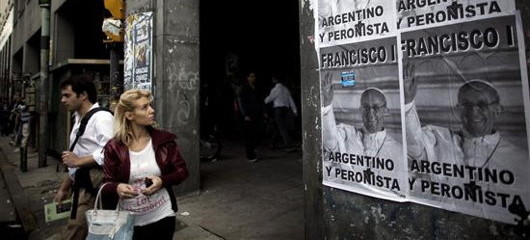
If God is an Argentine then, apparently, the pope is a Peronist. At least that, “a Peronist,” is how much of the local press has chosen to describe Argentine Cardinal Jorge Bergoglio, who on Wednesday was elected pope and took the name of Francis.
 MARTIN GAMBAROTTA
MARTIN GAMBAROTTABergoglio is a son of Buenos Aires. If you happened to stroll through Plaza de Mayo on any given day you could sometimes see Bergoglio preaching to his flock from the steps of the Buenos Aires Cathedral while life went on around him.
Plaza de Mayo has always been a historic place. Now visitors will want to take another look at the cathedral, which for years was the headquarters of who is now Pope Francis.
If Bergoglio’s appointment has redefined the way in which you will look at a building then imagine the effect it will have on the nation’s volatile politics.
Resident of Buenos Aires (aka porteño), now you know what global attention feels like.
The minute Bergoglio’s election was announced the telephones in newsrooms started to ring. (more…)
Pope Francis
THE SACRED COLLEGE have elected Jorge Mario Bergoglio, Cardinal Archbishop of Buenos Aires, to be Rome’s new bishop and our Supreme Pontiff. He has chosen to take the name of FRANCIS.
One immediately recalls the words Our Lord spoke to Francis of Assisi in the great saint’s vision at San Damiano:
We pray that the Holy Father will continue the work of his predecessors in safeguarding the flock, and will do his part to fulfil the task given to his namesake, St Francis of Assisi.
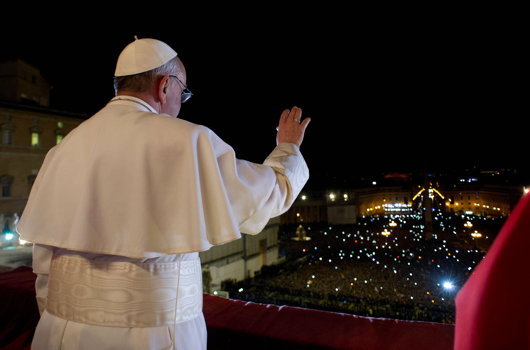
The Lenten Evening Oratory
Brompton Road, SW7 2RP
Lent 2013
Evening Oratory
with the Fathers
in the tradition of St. Philip Neri
WEDNESDAYS at 6.30pm
20.Feb.2013 – Little Oratory
The Oratory Choir
The Three Lenten Tasks: tasks for all the year
27.Feb.2013 – Little Oratory
London Oratory School Schola
Adversaries of the Spiritual Life: The Flesh, The World, The Devil
6.Mar.2013 – Little Oratory
The Oratory Choir
Our Lord speaks to His followers before the Passion
13.Mar.2013 – The Church
Holy Hour during 40 Hours Exposition (Quarant’Ore)
20.Mar.2013 – Little Oratory
Oratory Junior Choir
Our Lady’s Dolours (texts from Stabat Mater)
27.Mar.2013 – The Church
Tenebrae in Cena Domini
Vigil of Prayer at the Oratory
until
Friday 1 March 7am
There will be an Adoration Vigil (Exposition of the Blessed Sacrament) in the Little Oratory praying for the Church as we end the pontificate of Pope Benedict XVI, thanking God for all the graces during this pontificate and asking the guidance of the Holy Spirit for the cardinals as they meet to elect the new Pope.
The Vigil will begin Thursday 28 February at 9.30 in the evening and conclude with Mass at 7am the following morning.
Brompton Oratory
Brompton Road
London
SW7 2RP
Don Bosco in London
Just went to venerate the relics of Don Bosco, which are doing a UK-wide tour organised by the Salesian order. There was quite a crowd waiting for the Saint’s earthly remains to be unveiled at 2 o’clock — suprising for early afternoon on a workday. Before the relics were even made viewable there were pilgrims huddled around the veiled reliquary, whom the organisers eventually had to shoo away in order to organise some proper veneration.
The faithful are able to venerate the relics at Westminster Cathedral from 2:00pm to 8:30pm today and tomorrow only, after which they will spend the next two days at St. George’s Cathedral in Southwark before returning to Italy.
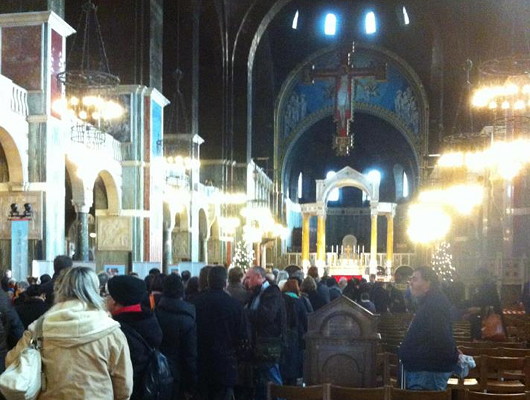
Tradtastic Hertfordshire
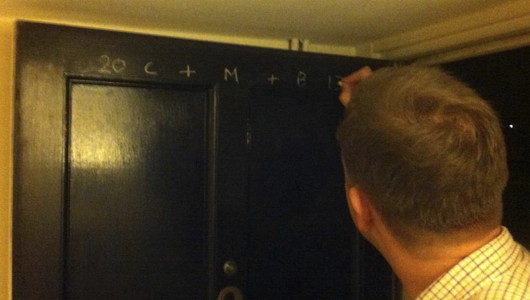
The bishops of England & Wales cunningly arranged for the Feast of the Epiphany to fall on the actual Epiphany this year. We had a great big festive lunch at our favourite little Italian place in South Ken, but the night before I went out to Hertfordshire, where I witnessed the tradition of a door being CMB’d with holy chalk for the new year (above).
Those unaware of this tradition can read a bit more here. The C+M+B stands both for Christus mansionem benedicat (“Christ bless this house”) and the names of the Three Magi: Caspar, Melchior, and Balthasar.
Return to Downside
Christmas was marked by a return to the Abbey Basilica of Saint Gregory the Great at Downside for Midnight Mass. The abbey church always has a splendid feeling at night. One of the best points at the wedding of the century was in the evening when, after a fair bit of dining and drinking, a whole slew of guests slipped into the church where the monks who a few hours previous had sung the nuptial mass were singing compline and joined in their prayers.
Doubtless you will recall last year’s Christmas diary documenting my holiday with Garabanda, Ming, und Familie. In the time since then, my own parents have very wisely moved onto the same landmass as I, and — even better — moved to nary a half-hour’s drive from Downside, so this Christmas was spent in blessed Georgian comfort with my own parents and all the delights of that particular patch of the West Country. (more…)
Fr Kramer on Tradition
Readers might enjoy this video from CNS featuring Fr Joseph Kramer, one of the FSSP’s priests in Rome. I met Fr Kramer very briefly on the street when I was in Rome in 2006. It might be time for another visit to the Eternal City.
Cardinal Manning
Over at Reluctant Sinner, Dylan Parry has an excellent post on Cardinal Manning, the second man to serve as Archbishop of Westminster. Manning is all too often forgotten, despite being one of the most widely loved and respected men of his generation. His funeral, famously, was the largest ever known in the Victorian era. Besides his wisdom at the helm of England’s most prominent see, the good cardinal’s greatest legacy might be his influence on Rerum Novarum, the great social encyclical of Leo XIII. Dylan is planning on writing further on the subject of Cardinal Manning, giving us something to look forward to. (more…)
St Andrew’s & Blackfriars Hall, Norwich
NORWICH, THAT CITY of two cathedrals, is known for Colman’s Mustard and the television cook Delia Smith (herself Catholic). Unknown to me until recently is that the capital of one of England’s greatest counties is also home to the most complete Dominican friary complex in all of England. The Dominicans had arrived in Norwich in 1226 — the swiftness with which they reached the city comparative to the foundation of the Order of Preachers is indicative of England’s inherent inclusion in the Catholic Europe of the day.
From 1307, the OPs occupied this particular site in Norwich until the Henrician Revolt, when the friary was dissolved and the city’s council purchased the church to use as a hall for civic functions. The nave became the New Hall (later St Andrew’s Hall) while the chancel was separated and used as the chapel for the city council and later as a place of worship for Norwich’s Dutch merchants. (The last Dutch service was held in 1929).
The complex has been put to a wide variety of uses. Guilds met here, as did the assize courts. It was used as a corn exchange and granary. King Edward VI’s Grammar School began here. Presbyterian and Baptist non-conformists worshipped in various parts during the late seventeenth century. William III had half-crowns, shillings, and sixpences minted here. In 1712, the buildings became the city workhouse until 1859, when a trades school was established the continues today elsewhere as the City of Norwich School. The East and West Ranges are now part of the Norfolk Institute of Art and Design. (more…)
The 8th Earl of Wicklow
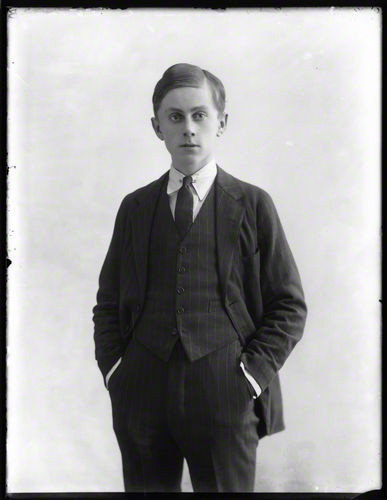
William Cecil James Philip John Paul Howard, 8th Earl of Wicklow (styled Viscount Clonmore from his birth until succeeding to the earldom in 1946) was received into the Church at the age of thirty in 1932. Having attended Mass with the family’s Catholic servants, he was banished from visiting the family home on Sundays in addition to being disinherited. He later married the architect Eleanor Butler who served in Seanad Éireann from 1948-1951. Above is one of three photographs of Viscount Clonmore in the collection of the National Portrait Gallery.
Catholic Ambassadors to the U.N.
Diplomats’ group hears Latin Mass at St Agnes
On Sunday 21 August 2011, the Church of St Agnes on 43rd Street in Manhattan was host to a group of Catholic ambassadors to the United Nations for the regular 11:00 Extraordinary Form Mass, offered by Fr. Richard Trezza OFM. (Fr. Cid, a recently ordained Franciscan priest was also in choro). The group included representatives from Grenada, Haiti, the Philippines, Korea, the United Kingdom, and Japan.
The informal gathering, formed just this year, is open to Catholic Permanent Representatives and Deputy Permanent Representatives — the first- and second-highest ranking diplomats at national missions to the U.N. — and has heard Mass at a number of different parishes around Manhattan. (more…)
Fra Freddy, Rest In Peace
Yesterday, I was very saddened to hear of Fra Freddy’s death. Fra Freddy was a legendary character whom I was introduced to in my first year at St Andrews. He was invited to speak to the Catholic students most years on some subject or another — an introduction to prayer or a lenten meditation. I was quite pleased when he was so taken with a poster I designed to advertise one of his talks that on his way back to Edinburgh he nipped out of the car at the last minute and grabbed a large copy. Fra Freddy was an old-fashioned stick-in-the-mud with a good sense of humour, but he also had the capability to surprise with a kind word when you least expected it.
Fra Fredrik John Patrick Crichton-Stuart was born September 6, 1940 to Lord Rhidian Crichton-Stuart (son of the 4th Marquess of Bute) and his wife Selina van Wijk (daughter of the Ambassador of the Queen of the Netherlands to the French Republic). He was raised in Scotland and North Africa (where his father was British Delegate to the International Legislative Assembly of Tangier) and was educated first at Carlekemp in North Berwick and then at Ampleforth. He joined the Order of Malta in 1962, later being named the Delegate for Scotland & the Northern Marches. In 1993 he was appointed Chancellor of the resurrected Grand Priory of England. Fra Freddy became Grand Prior himself when his cousin, Fra Andrew Bertie, died in 2008 and was succeeded by the then-Grand Prior of England, Fra Matthew Festing.
Fra Freddy was a devoted follower and promoter of the traditional form of the Roman rite. He joined Una Voce Scotland in 1996 and became secretary in 2000. Two years later he was named councillor and senior vice-president of FIUV, the International Federation ‘Una Voce’, and briefly served as its president in 2005.
Over the past year or so Fra Freddy had been varying ill but seemed to recover. I am told he was found dead yesterday morning, still clasping his breviary. He was well-known in Edinburgh and beyond, and he will be missed by his many friends as well as those who worked and volunteered with him or interacted with him in his charitable activities.
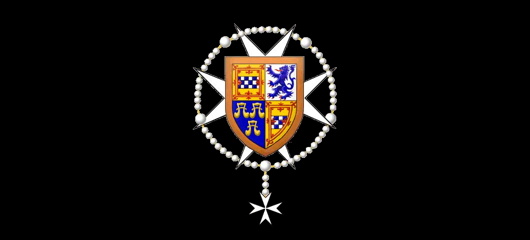
FREDERICK JOHN PATRICK CRICHTON-STUART
Grand Prior of England
of the
Sovereign Military & Hospitaller Order of St John
of Jerusalem of Rhodes and of Malta
6 September 1940 – 14 June 2011
Eternal rest grant unto him, O Lord,
and let perpetual light shine upon him.
May he rest in peace.
Amen.
Les fondements de notre civilisation occidentale
« Les fondements de notre civilisation occidentale sont chrétiens ; le respect du christianisme est une condition sine qua non d’une droite qui veut conserver non seulement la prospérité économique, mais ce qui est au fondement de toute prospérité durable : le souci du bien commun, le respect de la loi naturelle, le sens de la justice. »
The latest issue of Égards, the premier journal of traditional conservatism in Quebec, contains an interesting analysis of the current situation faced by the various streams of the centre-droit spectrum in the province. I am, however, very much against the perpetual organisation-founding that goes on in political circles. There seems to be a belief that, when in doubt, start a new organisation, but this is precisely what the author, M. Décarie, proposes.
Search
Instagram: @andcusack
Click here for my Instagram photos.Most Recent Posts
- Silver Jubilee November 21, 2024
- Articles of Note: 11 November 2024 November 11, 2024
- Why do you read? November 5, 2024
- India November 4, 2024
- The Lithe Efficiency of the Old Constitution November 4, 2024
Most Recent Comments
Book Wishlist
Monthly Archives
Categories

